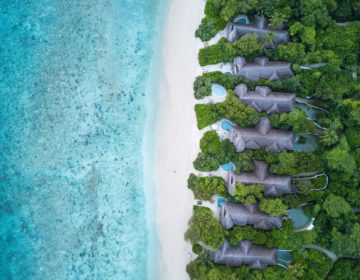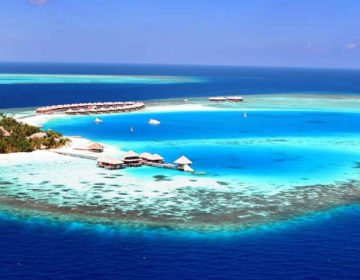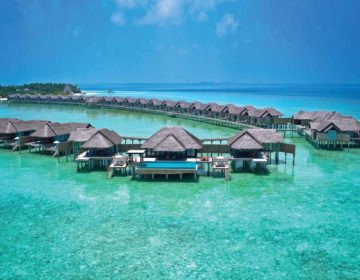One of the top attractions in the Maldives is the National Museum in Malé. Located in the Sultan Park, which was once a part of the site of the 17th century Maldivian Royal Palace compound, the three-story museum was established in the early 1950s with the purpose of preserving the culture and history of the country and instilling patriotism among the people of the Maldives. The museum is home to an extensive collection of historical artifacts that depict the history and rich cultural heritage of the country, ranging from ancient stone objects to fragments of royal antiquities dating back to the Buddhist era and the rule of Islamic monarchs.
 The National Museum complex is comprised of two large buildings separated by Sultan’s Park in the old palace grounds across from the gold-domed Islamic Centre on Medhu Ziyaarai Magu, also known as Grand Friday Mosque. Photo Credit: The National Museum, Malé.
The National Museum complex is comprised of two large buildings separated by Sultan’s Park in the old palace grounds across from the gold-domed Islamic Centre on Medhu Ziyaarai Magu, also known as Grand Friday Mosque. Photo Credit: The National Museum, Malé.
The Building
The National Museum complex is comprised of two large buildings separated by Sultan’s Park in the old palace grounds across from the gold-domed Islamic Centre on Medhu Ziyaarai Magu, also known as Grand Friday Mosque.
The old National Museum is housed in the only remaining building of the former Sultan’s Palace, now known as the Sultan’s Park. The three-story Edwardian colonial-style building boasts a collection of objects belonging to the Sultans, including the ornaments and costumes worn by various kings and queens, stone items of the Maldives’ pre-Islamic period, anthropological artifacts, paper and cloth manuscripts, arms and armor, photographs of essential personalities, and other articles that highlight the past Maldivian way of life.
The newer National Museum building is a conversion of the old palace building structure made up of steel and glass. Built and financed by the Chinese government as a gift to the country, the double-storey museum features interiors that have been retained from the days of the Sultanate, including the handwritten Qur’an engraved on the walls of the building. It also features an exhibition of 120 faiykolhu or Maldivian legal deeds and other official documents dating from the 1600s to the 1930s. The museum complex is surrounded by a beautiful garden park where locals can escape the hustle and bustle of the city.
 Photo Credit: The National Museum, Malé
Photo Credit: The National Museum, Malé
The Collection
The National Museum houses a collection of incredible artifacts and relics from the foregone pre-Islamic period era, including ceremonial robes, headgear, thrones, palanquins, royal sunshades and furniture used by Sultans. The museum also exhibits the first printing press used in the country, the rifle used by Mohamed Thakurufaanu in his fight against the Portuguese in the 16th century, and other figures dating from 11th century, excavated from former temples.
There is also an impressive display of age-old cannons, broken pieces of Buddhist and Hindu idols, images of political events, stunning lacquer work boxes, and a replica of the pen that was used to sign the ‘Declaration of Independence’ from the British Empire.
The lower level of the museum boasts galleries devoted to the ancient and medieval periods of Maldivian history. Items on display include religious paraphernalia, weaponry, and household wares as well as many impressively carved Arabic- and Thaana-engraved pieces of wood commemorating the conversion of Maldives to Islam in 1153.
 Items on display include religious paraphernalia, weaponry, and household wares. Photo Credit: The National Museum, Malé
Items on display include religious paraphernalia, weaponry, and household wares. Photo Credit: The National Museum, Malé
The second floor of the museum exhibits artifacts from the modern period, which delve into the culture and history of the Maldives. Prized artifacts include beautiful lacquer-work boxes, and various pieces of antique technology including the country’s first gramophone, telephone, and a large computer. Other fascinating pieces on display include a massive six-meter skeleton of the Longman’s Beaked Whale, which has not yet been seen alive in the sea, and the famous underwater cabinet meeting held under President Nasheed in 2009.
Highlights of the collection include an 11th-century coral stone head of Lord Buddha from Alifu Thoddoo; a 13th-century engraved wooden plank from Hukuru Miskiiy, the Feyli Kolhu worn by the Sultan Ghaazee Mohammed Thakurufaanu-al-A’z’am, which is an excellent example of the intricate craftsmanship of the Maldivian weavers in the 16th century.
 Highlights of the collection include an 11th-century coral stone head of Lord Buddha from Alifu Thoddoo. Photo Credit: The National Museum, Malé
Highlights of the collection include an 11th-century coral stone head of Lord Buddha from Alifu Thoddoo. Photo Credit: The National Museum, Malé
Destruction of Pre-Islamic Artifacts
In February 2012, the museum was broken into by a mob of religious extremists during political protests against former President Nasheed, and its most precious items, some 30 ancient Buddhist coral stone carvings from the country’s pre-Islamic period, were destroyed for being ‘idols.’ Among the damaged objects were an 18-inch-high bust of Buddha, a six-faced coral statue, and assorted limestone and coral statues.



